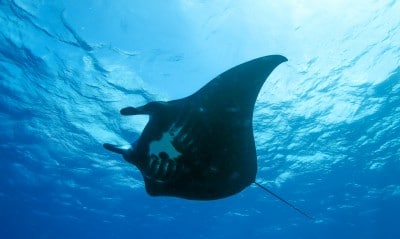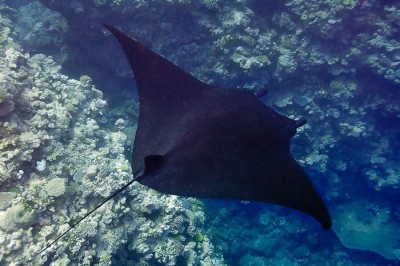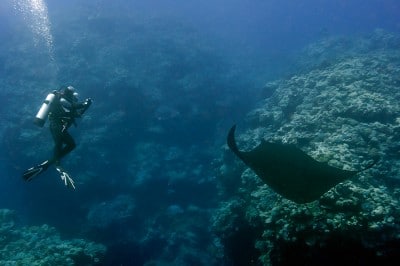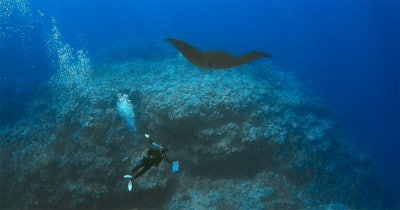As I clambered dripping onto the boat after our second dive of the day on the west side of Huon Atoll, I was greeted by a cacophony of dive chatter- a sure sign that something eventful had been seen.
To me this had been a fairly average dive. Staring at my transect line laid across a seafloor, I meticulously noted the assortment of corals, algae and sponges. Such is often the lot of the benthic ecologist, but I was completely unaware as a manta ray swooped above.

As the manta swooped over, the gill rakers used to strain zooplankton from the water column can clearly be seen.

The manta ray passed only a few meters below scientific diver Ken Marks, affording this excellent topside view of one of the most iconic of reef creatures.
Other members of the dive team who are surveying fish, or searching for marine invertebrates, often look forward and scan the water column. These divers were treated to a magnificent marine wildlife experience, as the manta ray glided between and around them.

Scientific diver Daphné Grulois is treated to a fantastic view as the manta glides past.

The manta ray swoops over scientific diver Badi Sameniego, who expresses his obvious delight.
Mantas are the largest of the eagle rays and actually consist of two different species, Manta birostris and Manta alfredi. The larger of these two species can have a wingspan up to 7 meters! Their size, coupled to their grace and elegance of movement, help to make mantas iconic marine reef creatures. Though the manta is a large ray, none of the divers felt threatened. At only a couple of meters across this particular manta ray was relatively small, but more importantly mantas are docile reef creatures with no teeth. They strain their food from the water, microscopic animals known as zooplankton, using their gill rakers.

Silhouetted against the sun above, the size of the manta can be seen compared to scientific diver Kate Fraser hovering nearby.
Sadly mantas, already an occasional visitor to the coral reef, are becoming rarer. Manta rays are vulnerable to fishing pressure, since they have a long life cycle, may be accidently captured in gill nets, and are harvested for their gill rakers to be used in various Chinese medicines.
This chance encounter, though brief, was therefore one to treasure for our divers.
Photos: 1,4,5 – Serge Andrefouet; 2,3 – Ken Marks